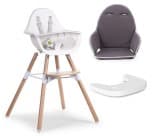 The odds are you've heard how important Tummy Time is for your baby's development. But maybe you think that Tummy Time is just about neck strength? It’s more than that – It’s uncovering a whole secret world of skills your baby has, that you otherwise may have missed! Watching your baby develop their skills through tummy time is fascinating!
The odds are you've heard how important Tummy Time is for your baby's development. But maybe you think that Tummy Time is just about neck strength? It’s more than that – It’s uncovering a whole secret world of skills your baby has, that you otherwise may have missed! Watching your baby develop their skills through tummy time is fascinating!
The Newborn Tummy Time
By starting tummy time in the first week of life of a healthy, full term baby, it can improve tummy time down the road. Even when they aren’t lifting their head, early tummy time is important for helping baby stretch out of their curled up foetal position from the womb.
During these first 2 weeks, most tummy time is cheek down. Baby will try to lift their head and turn it with great effort. Their arms are bent with hands near shoulders. Knees are bent and under hips (bottom in the air). And your baby may make "crawling" or "pushing" motions with their feet.
1 to 2 Month Old Tummy Time
By this age baby can briefly lift their head (usually bobbing, not still) to about 45 degrees. They turn their head to place opposite cheek down. They will be comfortable with either cheek down. Legs begin to straighten during tummy time so that the lower belly touches the surface beneath baby. Arms move further away from the body and in the second month, they will begin to press hands down into the surface to push the shoulders and very top of the chest up very slightly off the surface beneath.
Baby will lift their head and turn it to one side. This shows that baby is using the muscles of one side of the neck. As their brain-body connection develops in the first few months, they'll begin to use both sides of the neck at the same time to lift and hold their head steady in tummy time. It looks like they just got stronger, but actually this is one of the first times they’re practicing using the two sides of their body together in a coordinated way!
3 Month Old Tummy Time
By this age your little one may be able to lift their head 45-90 degrees and hold it without bobbing. Baby turns head to look both directions with head lifted and elbows most often under or in front of shoulders. Occasionally baby will lift shoulders and very top of chest off surface by pressing weight into forearms and baby may accidentally roll belly to side if they turn their head too far
4 Month Old Tummy Time
By 4 months old your baby may be able to lift and hold their head steady to 90 degrees. They can do presses through forearms to lift upper chest and baby can keep chest lifted as they look down. Your baby may lift arms and legs off floor and rock or appear to be "swimming" or "flying". It seems to make no sense that your baby assumes the "swimming" or "flying" position when they sees a toy in front of them that they want. But rest assured, alternating between two different movements - this one and propping on the forearms - is an awesome indication of motor coordination and a sign that your little one is gearing up to crawl in coming months.
5 Month Old Tummy Time
As your baby gets more ability to roll out of Tummy Time, you'll likely see shorter periods of belly-down play. You’ll notice baby beginning to reach for objects and baby may begin to roll intentionally from belly to side lying. They’ll also begin to press through straight arms to lift chests off surfaces. Continuing to offer plenty of floor time play is important for letting your little one practice all these new skills and develop new ones.
6-7 Month Old Tummy Time
Tummy time is as important for the development of hands, as it is for their neck. The fact that they can press down through open hands is a result of stretching and strengthening of their finger muscles – which have been developing though tummy time in the past months.
You’ll now notice your baby can reach with one arm and will also begin to push backwards on their belly using their arms or push themselves up off the floor – in a push up position. They’ll also have their palms flat on the floor – not always fisted as they would have previously. Baby may also begin to pivot in a semi-circle using their arms.
At some point your baby will be a master at tummy time, and they will move on from this position. They’ll move onto getting onto hands and knees, rolling and pushing up to sit. Continue to give your little one plenty of daily floor time play – this will help them build their strength and skills.
Baby Tummy Time
Posted: 11th November 2016
In:






